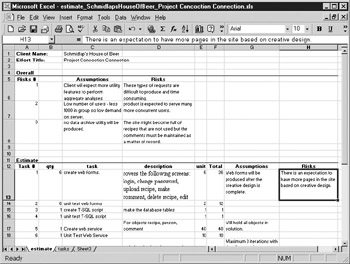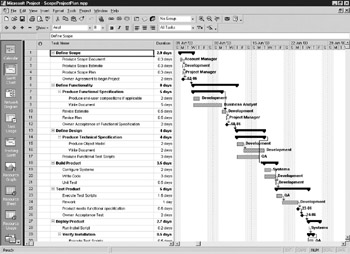Define Project Scope
|
|
The goal of the scope process is to get the owner to commit to providing resources to fund the solution. A proposal for a solution is presented to the owner, and if successful, the owner is obligated to provide the resources needed to build the solution. A proposal consists of the following:
-
A brief statement of work
-
A qualified schedule for delivery
Because there is no assurance that the potential owner will agree to fund the entire effort, the project manager must define what’s appropriate to include in the proposal. The effort applied to preparing the proposal should be consistent with the relationship that your organization has with the potential owner. For example, the potential owner told the account manager that they are willing to accept the proposal if particular information is included. In this case, great effort should be made to ensure that the proposal meets the owner’s expectations, because the chances are quite high that the owner will accept it. In another situation, you may have little or no insight into the owner’s motives regarding the proposal and, therefore, devoting a great deal of effort to producing the proposal is more likely to be a waste of time¾especially if there are many competitors proposing solutions.
You should also consider the risk of obligating your organization when all of the facts are not clearly known. If no opportunity exists to revise the schedule after the requirements gathering has been performed, than certain efforts performed in the define functionality step should be performed in the scope step. The owner should be made aware of the qualifications that shroud the proposal and understand that functionality beyond the qualifications will add to the expense and execution time of the effort.
After an account manager produces the statement of work, development produces a qualified estimate based on the statement of work. Next, the project manager assembles a plan to determine whether the work can be performed, when it can be completed, and date constraints, deliverables, and milestones.
After being presented with the proposal, the owner will hopefully agree to the terms in writing. Then the next step of the process begins—defining functionality. Table 18-1 summarizes the deliverables in the scope step and the party responsible for their production.
| Execution Order | Deliverable | Responsible Party |
|---|---|---|
| 1 | Description of owner's expectations - statement of work | Account manager |
| 2 | Qualified estimate for scope | Development |
| 3 | Qualified project plan for scope | Project manager |
| 4 | Owner acceptance of the scope and proposed delivery date | Project manager |
Statement of Work
At the beginning of many software solution engagements, an owner has some ideal that is presented to an organization that will create the solution. Alternatively, an account manager could approach an owner to determine whether new work could be contracted. In any case, either the owner or the account manager defines the outcome of the work, which is set as the statement of work. The statement of work could be described in a 15-minute phone conversation, written on a couple sheets of paper, or summarized in a 15-word sentence. The following represents a sample statement of work:
Sample Statement of Work
The owner wants a web site that will allow a manager to post a recipe to a web site. The employees under the manager need to be able to post comments about the recipe. Everyone can read the comments for a recipe posted by their respective manager.
Owner needs a host for the application.
They want it in three weeks to meet a 22 June date for beer brewing trade show.
Scope Estimate
The goal of a scope estimate is to produce a qualified basis for the development time that may be necessary for completing a project. Development creates a scope estimate to inform the team the development resources required from a technical perspective. The qualifications in the estimate serve to offer the team more information about what the development staff thinks the owner wants. Qualifications also cover the points that should be understood about the product or how it will be delivered to the owner. Many programmers consider the effort of providing a scope estimate risky and difficult, since the known requirements are undefined at this point. Clearly, the sample statement of work shown previously is vague, and the solution could require three weeks of work or three years of work, depending on the exact requirements of the project.
An effective strategy for producing a scope estimate is to identify all of the deliverables that are necessary for producing the solution. After the deliverables are identified, they should be qualified in terms of the assumptions surrounding their production and the risks associated with production. The deliverables should also be identified to the extent possible in terms of the scoped requirements they fulfill. The team participating in the estimate may view a developer’s qualifications in an estimate as a counterproductive effort that the developers use to protect themselves. Qualifications should be viewed as the initial framework for how the solution can function. Likewise, developers should qualify the estimate as much as possible to communicate to the team the issues they believe will affect the resources required to produce the solution. In Figure 18-2, the sample statement of work document was used as the basis for a web site that maintains beer-brewing recipes in a local brewer’s supply store.

Figure 18-2: Spreadsheet example of a scope estimate
Scope Project Plan
To help reduce the risk of an owner building impossible expectations, a qualified scope project plan should be produced. The scope project plan at this point should be an overview of the steps of the unified process with the dates based on the project starting date and the development estimate for the deliverables. Milestones for the owner’s participation should also be included, such as dates that the owner must provide feedback or acceptance of parts of the project. Figure 18-3 shows a sample project plan Gantt chart. (If you’re not familiar with Gantt charts, see the following sidebar.)

Figure 18-3: Sample project plan Gantt chart produced in the scope step
Predicting the future is complicated. You have to figure out what tasks need to be performed and who should perform them. You also have to consider the dependencies for completing tasks. For example, you cannot back a car out of the garage until you open the garage door.
The Gantt chart is designed to graphically display the following:
-
The tasks in a project
-
Who is responsible for completing the tasks
-
The dependencies tasks have on other tasks or events
-
The dates expected for completion of the tasks
The Gantt chart is useful for showing your prediction of the future. Although a Gantt chart may not help you see the future exactly, it does make your predictions easier for others to visualize.
Gantt charts may be built using project management software. Microsoft Project is the most popular software tool used for this purpose, but other tools like Visio can also be used. The chart shown in Figure 18-3 was prepared using Microsoft Project.
The scope project plan also serves an important role in providing an initial understanding as to the size of the work. If the scope estimate’s assumptions were correct and the plan demonstrated that the work could not physically be performed within the required time frame, an alternative strategy would have to be adopted that might require the owner to accept an alternative scope, a phased approach to the delivery of the solution by increasing the iterations, or an alternative design to be pursued by the development staff.
When the plan and all proposal related materials are completed, the proposal can be assembled and delivered to the owner. If the owner accepts the proposal, the project will likely be tuned over to the project manager to complete. If the owner does not accept the proposal, the account manager may have to present other versions of the scope document and the project plan.
|
|
EAN: 2147483647
Pages: 193